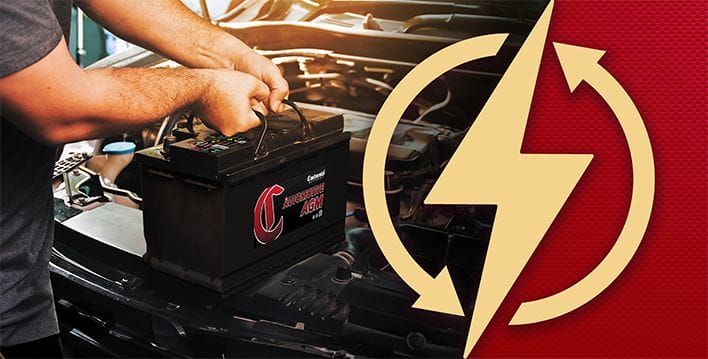
There’s nothing quite like slipping into the saddle of your jet ski and skipping across the waves on a warm summer day. To keep the good times going, don’t forget to take care of basic battery maintenance. After all, the battery is the heart of your machine, keeping it running and you riding all summer long.
In this blog post, we’ll offer a guide to your jet ski battery, including:
- Best batteries to use for jet skis
- Tips for maintaining the health of your jet ski battery
- Signs it’s time to replace your jet ski battery
What Is a Jet Ski Battery?
Broadly, it’s the battery used to power your personal watercraft. These are typically sold under the title of powersport batteries. They are specially designed for vehicles and equipment that require a lot of power and experience rough terrain or vibration.
The Best Type of Battery for a Jet Ski
Jet skis can use a variety of types of batteries, depending on the make and model of your watercraft. Be sure to check your manual for the manufacturer’s battery recommendations.
AGM. Generally, the best type of battery for a jet ski is an AGM or absorbed glass mat battery. AGMs are a type of lead-acid battery that is fully sealed, maintenance-free and spill-proof. They contain fiberglass mats between each lead plate that trap the liquid electrolyte.
AGMs are durable, vibration resistant and pack the high-power output punch needed for your jet ski. Due to their popularity, they are also fairly easy to find and cost-effective.
Lithium. Lithium jet ski batteries are lightweight and tend to last longer than their AGM counterparts.
AGM vs. Lithium-ion Jet Ski Batteries
| Features | Drawbacks | Lifespan | Performance | Cost | |
| AGM | Affordable, Maintenance-free, Good cold-cranking amps (CCA), Spill-proof design | Heavier, Shorter lifespan compared to lithium | 3-5 years | Performance may drop over time | Lower up-front cost |
| Lithium-Ion | Lightweight, Long lifespan, High energy density, Fast charging | Higher initial cost, Requires special charger, Sensitive to extreme temperatures | 5-10 years | Consistent power output | Higher up-front cost |
5 Tips for Maintaining a Healthy Jet Ski Battery
Jet skis are naturally exposed to conditions that can be harsh on batteries, such as jostling and vibration, high temperatures and water. Caring for your jet ski battery can ensure the most life and optimal performance.
1. Match your battery to the climate. Extreme heat can drain a battery, leading to a faster discharge. If your region experiences extended periods of hot weather, opt for a battery with a higher reserve capacity, which can maintain its charge longer — especially on extremely hot days.
2. Watch the water. Marine environments can be harsh. You’re exposed daily to moisture and vibration, two things that batteries tend not to like. Ocean wave riders can add saltwater to that list.
- If you’re a saltwater rider, rinse off your jet ski, including the battery and connections, with fresh water and a salt terminator solution.
- Store your battery outside the jet ski in a dry, well-ventilated area.
- Choose batteries designed for vibration resistance, like AGM.
- Inspect the battery and regularly check for corrosion, damage or loose connections.
3. Practice proper maintenance. Even though both AGM and lithium batteries are maintenance-free, that doesn’t let you off the hook for taking proper care of your battery and, thus, your vehicle. Proper battery maintenance includes:
- Regular charging after every use, and especially during the off-season.
- Cleaning connections if you notice corrosion building up on the terminals.
- Regular inspections to check for loose connections and corrosion.
- Disconnecting the battery when not in use.
- Avoid overcharging, which can significantly damage the battery.
- Use your battery. Inactivity can lead to sulfation. Make sure to run your jet ski regularly throughout the season.
4. Store smart. Proper battery storage can affect the lifespan and functionality of your batteries. When you’re out on the waves frequently, it makes sense to keep your battery inside the jet ski. At the end of the season, it’s best to disconnect your battery and store it separately. Check out these tips for proper storage when you’re done riding the waves for the season.
- Do not store your battery in the jet ski for long periods of time. Remove it and store it separately.
- Store your jet ski battery in a climate-controlled location. Batteries prefer cooler temperatures, but make sure your battery always remains above freezing.
- Monitor your battery’s voltage every four to six weeks. When it reaches 70% state of charge, give it a boost charge.
- If your battery will sit idle for months at a time, connect it to a battery tender. This type of jet ski battery charger will only charge when the voltage drops and shuts off before it overcharges.
5. Find the best replacement. Even the best batteries don’t last forever. When it is time to replace your jet ski battery, find a replacement that will give you the power and performance you need.
- Check the owner’s manual to ensure the replacement battery meets your watercraft’s specifications and physical dimensions.
- Invest in a high-quality battery that will save time and money in the long run.
- Purchase from a reliable retailer that specializes in powersport batteries.
- When installing the new battery, make sure that it is securely placed and the connections are correct.
Signs It’s Time to Replace Your Battery
How do you know when it’s time to replace your jet ski battery? The surest sign is if your jet ski doesn’t start. But there are symptoms that can indicate a dying battery. Pay attention to the following, and you can make sure to get a replacement installed rather than be left stranded by surprise.
- Slow cranking engine. It may be time to replace your battery if it takes several attempts to get the engine going.
- Dimming lights or electronics. If you notice the electronic components of your jet ski, including the lights or radio, aren't functioning properly, it may be due to a failing battery.
- Frequent need for recharging. If your battery cannot hold a charge for a reasonable amount of time, it’s likely on the way out.
- Swelling or bulging. If you see cracks, swelling or bulging on your battery, do not turn on your machine. Have it professionally removed and replaced immediately.
- Warning lights. Most jet skis have dashboard lights that indicate a battery issue. Watch for a battery icon or the words “low battery voltage.”
- Battery age. When well maintained, AGM batteries typically last up to five years, while lithium can last up to 20 years.
Be Ready for Your Next Adventure
Whether you’re an avid wave enthusiast or a weekend rider, you want your jet ski to be powered up and ready to go every time you hit the water. By choosing the right battery and practicing proper maintenance, you can be sure your jet ski runs smoothly all season long.







